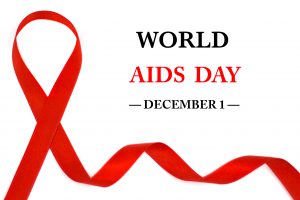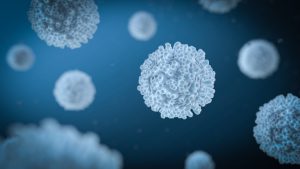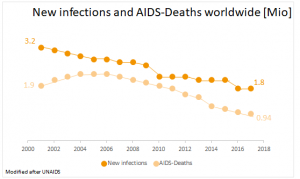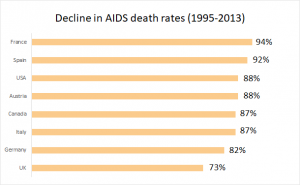
Because of the World-AIDS-Day today, there is a new post about HIV and AIDS in general, the major breakthrough in HIV therapy and a first success in personalized medicine.
HIV infection and AIDS

AIDS (acquired immunodeficiency syndrom) is triggered by the human immodeficiency virus (HIV), which belongs to the family of retroviruses. Viruses can only replicate in foreign cells, so-called host cells and are thus dependent on them.
Our immune system is responsible for fighting against pathogens such as fungi, bacteria or viruses and destroying dead or sick cells. If a human is infected with the HI virus, the immune system is damaged because the virus primarily attacks immune cells, so-called helper cells: Their own genetic material is incorporated into the genome of the host cell, the virus can thereby merge with it and kill them.

The helper cells, which belongs to the white blood cells, leucocytes, actually control other cells in the immune response, but can now due to the infection no longer perform this function. Thus, the immune system is weakend more and more.
The virus is transmitted via fresh wounds and mucous membranes through contact with body fluids such as blood, sperm, vaginal secretions and breast milk. Shortly after infection, the virus proliferaties rapidly and at the same time, the number of helper cells decreases as they are attacked and destroyed.1 After this acute phase, the cronic phase follows, in which the equilibrium is relatively constant. In the case of an untreated infection, this eventually leads to an acquired immune deficiency syndrom after a long, usually symptom-free phase.1 However, not every infection with the HI virus automatically leads to AIDS.
Due to the permanently weakend immune system, there are other risks for HIV-infected people. For example, they have a 50-fold increased risk of a infection with tuberculosis.2 At the same time, tuberculosis infection can also accelerate the onset of AIDS.2 Both infections are mutually reinforcing.2 Tuberculosis is therfore the leading cause of death among people living with HIV.3
Epidemiology
Since the early 1980s, a veritable pandemic has developed. Worldwide, approximately 36.9 million people are infected with HIV (as of 2017), including more than 3.3 million children under the age of 15.4 So far, the virus has claimed a total of 39 million people (as of 2015). There are about 84,700 infected people in Germany.5

However, worldwide both the number of new infections as well as the number of AIDS deaths has steadily declined in recent years.
On the one hand, this is due to the ever-better education, on the other hand because of the successful antiretroviral therapy (ART): this suppresses the increase of the virus in the body and prevents developing AIDS. More than half of all HIV-positive people worldwide receive these life-saving drugs, with the result that the total number of AIDS-deaths was almost halved between 2005 and 2016.6
HAART
 Although medications have been available since 1987, the death rate increased enormously at that time. The major breakthrough in HIV therapy was the introduction of highly active antiretroviral therapy (HAART) in 1993 combining at least three drugs. Since then, the mortality rate has fallen rapidly in some countries – even 94% in France.8 This effective combination treatment puts the virus below the detection limit – preventing the onset of AIDS. In addition, further transmission of the virus is prevented. However, according to a recent study, only 53% of respondents know about this fact.7
Although medications have been available since 1987, the death rate increased enormously at that time. The major breakthrough in HIV therapy was the introduction of highly active antiretroviral therapy (HAART) in 1993 combining at least three drugs. Since then, the mortality rate has fallen rapidly in some countries – even 94% in France.8 This effective combination treatment puts the virus below the detection limit – preventing the onset of AIDS. In addition, further transmission of the virus is prevented. However, according to a recent study, only 53% of respondents know about this fact.7
UNAIDS
UNAIDS, the United Nations HIV/AIDS program has set the goal of 90-90-90 in the fight against AIDS. This means that by the year 2020, 90% of all infected people worldwide should know about their disease, of which 90% should be in treatment, of which 90% should be below the detection limit and therefore no longer be able to pass on the virus.9 While many countries has reached this target, Germany has reached 86-86-93 in 2018.9 The major problem with the fulfillment of this campaign is no longer the treatment or prevention of the outbreak of AIDS, but the diagnoses:10 in Germany there are about 13,000 people infected, but don’t know this. So, much has to happen in the next few years.11
Personalized Medicine

One of the active ingredients used in HAART is Abacavir, which has now been approved for personalized treatment.12 Drugs containing this substance should only be prescribed after a genetic test has been perfomed, provided that it is negative.12 This test is for the presence of the gene marker HLA-B*5701, which triggers a hypersensitivity reaction to the active substance. The HLA system (human leucocyte antigen) describes a group of genes that are central to the immune system. HLA-B belongs to the class I antigens, which, like all other HLA genes, lie on a 4 million base pair stretch on chromosome 6. Of this gene, at least 31 different alleles exist. In HIV patients with the allele HLA-B*5701 occure severe side effects, which can be lethal, after ingestion of Abacavir.12 This is in the case of 5% of all patients.12 The prescribed genetic test may exclude this hypersensitivity reaction and patients should prescribed other medicines which are harmless and effective for them.
Thus, also in this area a success in the direction of personalized medicine was recorded.
There will be more on this topic and another breakthrough in HIV therapy in the next blog.
Contact Person:
Kristina Schraml (kristina.schraml@biovariance.com)



